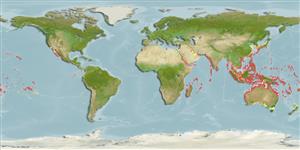Common names from other countries
Classification / Names / Names
Namen | Synonyme | Catalog of Fishes (gen., sp.) | ITIS | CoL | WoRMS
Environment: milieu / climate zone / depth range / distribution range
Ökologie
; tiefenbereich 10 - 30 m (Ref. 337). Tropical
Indo-Pacific.
Length at first maturity / Size / Gewicht / Alter
Maturity: Lm ? range ? - ? cm Max length : 8.0 cm SHL Männchen/unbestimmt; (Ref. 349); common length : 6.5 cm SHL Männchen/unbestimmt; (Ref. 349)
Collected by coastal populations in the tropical West Pacific for food and shell trade (Ref. 349). Often very common (Ref. 349). Found at depths of 10 to 30 m, on alga-covered rock (Ref. 337), and on coral reef flats on coral atolls and in tide pools on thin alga-sand bottom (Ref. 87884).
Life cycle and mating behavior
Geschlechtsreife | Fortpflanzung | Ablaichen | Eier | Fecundity | Larven
Members of the order Neotaenioglossa are mostly gonochoric and broadcast spawners. Life cycle: Embryos develop into planktonic trocophore larvae and later into juvenile veligers before becoming fully grown adults.
Poutiers, J.M. 1998. (Ref. 349)
IUCN Rote Liste Status (Ref. 130435)
CITES Status (Ref. 108899)
Not Evaluated
Not Evaluated
Bedrohung für Menschen
Harmless
Nutzung durch Menschen
Fischereien: kommerziell
| FishSource |
Tools
Mehr Information
Alter/GrößeWachstumLänge-GewichtLänge-LängeMorphologieLarvenDichte
Internet Quellen
Estimates based on models
Preferred temperature
(Ref.
115969): 23.8 - 29, mean 27.8 (based on 432 cells).
Verwundbarkeit
Low vulnerability (10 of 100).
Preiskategorie
Unknown.
